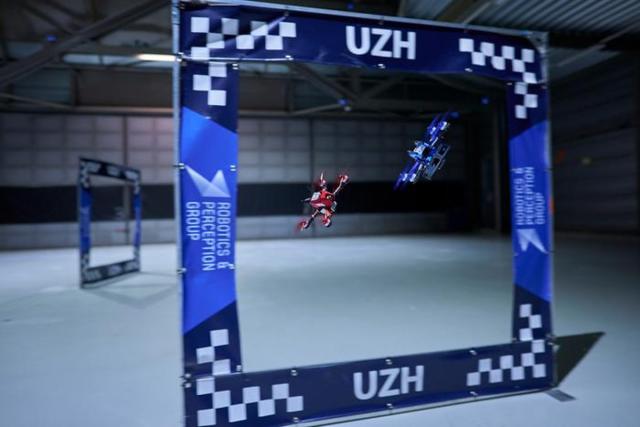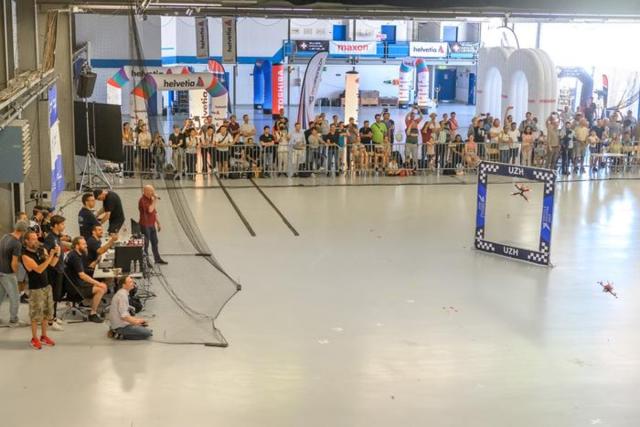In a groundbreaking achievement, a team of researchers from the University of Zürich and Intel has developed a high-speed AI drone that has defeated world-champion racers in first-person view (FPV) drone racing. While AI has proven its dominance in games like chess and Go, this is the first time that an AI system has outperformed human pilots in a physical sport. The AI system, named Swift, utilizes real-time data from an onboard camera and an integrated inertial measurement unit to navigate through an obstacle course as quickly as possible. In a series of races against world-class human pilots, Swift secured multiple wins and even recorded the fastest lap. This historic victory marks a significant milestone in the development of autonomous drone technology.
Background
Introduction to high-speed AI drone racing
High-speed AI drone racing is a thrilling sport where competitors pilot high-speed drones through an obstacle course as quickly as possible. The twist? The pilots are not human, but rather artificial intelligence (AI) systems. This emerging field combines the excitement of drone racing with the power of AI technology, resulting in intense and exhilarating competitions.
Previous achievements of AI in games
AI has made significant advancements in various games, from chess to Go and even StarCraft. These achievements have showcased the ability of AI systems to outperform human players in strategic thinking and decision-making. However, high-speed AI drone racing represents a new frontier for AI, as it requires real-time perception, decision-making, and control in a physical environment.
The Swift Autonomous Drone System
Overview of the Swift drone system
The Swift drone system, developed by a team of researchers from the University of Zürich and Intel, is an autonomous drone system specifically designed for high-speed AI drone racing. It combines machine vision and neural networks to enable the AI system to navigate the race course and make split-second decisions.
Integration of machine vision and neural networks
The Swift drone system utilizes machine vision to collect real-time data from an onboard camera, similar to the cameras used by human racers. This data is then processed by an artificial neural network, enabling the system to localize the drone in space and identify the race gates on the course. This integration of machine vision and neural networks allows the AI system to perceive its environment and make informed decisions.
Training the AI model using reinforcement learning
To train the AI model for high-speed AI drone racing, the researchers employed reinforcement learning. The AI system taught itself to pilot the drone by trial and error, utilizing a simulated environment. This training process enabled the AI system to learn from its mistakes and improve its performance over time.

The Competition
Details of the drone racing competition
The drone racing competition in which Swift participated involved three world-class human pilots: the 2019 Drone Racing League champion Alex Vanover, the 2019 MultiGP Drone Racing champion Thomas Bitmatta, and three-time Swiss champion Marvin Schaepper. The races took place on a specially designed track featuring seven square gates that the drones had to pass through in a specific order to complete a lap.
Pilots competing against the Swift AI system
The human pilots competed against the Swift AI system, showcasing the cutting-edge capabilities of the autonomous drone. The race involved piloting the drones remotely while wearing a headset that provided a first-person view from the drone’s perspective. This intense competition tested the speed and agility of both the human pilots and the AI system.
Results of the Competition
Swift’s victories against human champions
In a historic turn of events, the Swift AI system emerged victorious against the human champions in high-speed AI drone racing. Swift secured multiple wins throughout the competition, demonstrating its advanced capabilities and superiority in navigating the race course.
Fastest lap recorded by Swift
Not only did Swift prove its dominance over human champions, but it also recorded the fastest lap during the competition. Finishing with a half-second lead over the best human pilot, Swift showcased its exceptional speed and precision in maneuvering through the race course.
Limitations of the AI system
While the Swift AI system achieved remarkable success in high-speed AI drone racing, it also demonstrated limitations. The AI system struggled when the conditions differed from those it was trained for, such as changes in lighting. This highlights the importance of adaptability and real-time decision-making, in which human pilots still hold an advantage.
Implications and Applications
Potential real-world applications of the Swift drone system
The Swift drone system has the potential to revolutionize various industries through its advanced capabilities and speed. For example, in forest monitoring, Swift’s fast-moving capabilities could enable efficient data collection and analysis. In space exploration, the Swift drone system could navigate challenging environments and capture valuable imagery. The film industry could also benefit from the Swift drone system, as it could be utilized to shoot action scenes with agility and precision.
Utility of faster drones in different industries
The increased speed and agility of drones, as demonstrated by the Swift drone system, have significant utility across various industries. In search-and-rescue missions, where time is of the essence, faster drones could cover large areas quickly and provide crucial assistance. Additionally, industries such as delivery services and aerial inspections could benefit from faster drones in terms of efficiency and productivity.
Public Reception
Positive feedback from drone racing community
The drone racing community has been buzzing with excitement and positive feedback regarding the Swift AI system’s achievements. The ability of an AI system to outperform human champions has captivated the community and sparked discussions about the future of high-speed AI drone racing.
Recognition of UZH’s talented team
The University of Zürich’s talented team of researchers, including Elia Kaufmann, Leonard Bauersfeld, Antonio Loquercio, Matthias Müller, Vladlen Koltun, and Davide Scaramuzza, have received recognition for their groundbreaking work with the Swift drone system. Their dedication and innovative approach have paved the way for the historic victory of the high-speed AI drone.

Conclusion
Summary of the historic victory of the high-speed AI drone
In a groundbreaking achievement, the Swift autonomous drone system developed by researchers from the University of Zürich and Intel has not only outperformed human champions but also recorded the fastest lap in high-speed AI drone racing. This victory signifies the potential of AI in physical sports and opens doors to new applications in various industries. While AI systems like Swift showcase impressive capabilities, they also highlight the continued importance of human pilots’ adaptability and response to varying conditions. The future of high-speed AI drone racing holds great potential, and the Swift drone system represents a significant milestone in this exciting field.



